Get free scan and check if your device is infected.
Remove it nowTo use full-featured product, you have to purchase a license for Combo Cleaner. Seven days free trial available. Combo Cleaner is owned and operated by RCS LT, the parent company of PCRisk.com.
What kind of malware is SoupDealer?
SoupDealer is a Java-based three-stage malware loader capable of bypassing traditional antivirus and sandbox solutions. Cybercriminals were observed targeting computers running Windows operating systems located in Turkey. The malware is used to obtain remote access to infected systems.
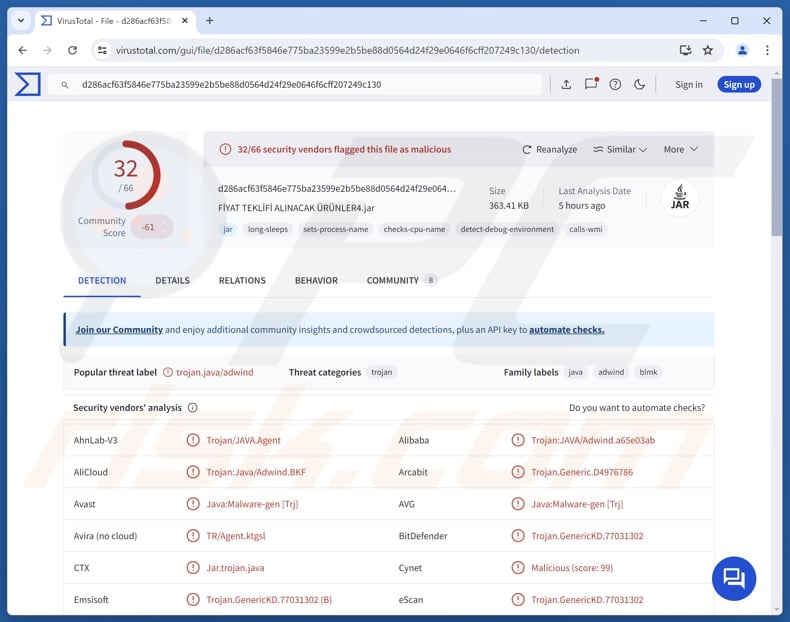
More about SoupDealer
The malware starts as a Java file that is scrambled with junk code to make it hard for security tools to decompile. It contains hidden code that executes the next stage using decryption. After being executed, the next piece of the malware is loaded directly into the computer's memory.
This stage is also encrypted and needs to be decrypted before moving to the next stage. The final (third) stage is the actual malicious program, SoupDealer. Before running, it checks if the computer uses Windows, has enough resources (RAM, CPU), is located in Turkey (or another specified country), and is not protected by an antivirus.
If everything checks out, the malware makes itself persistent by adding scheduled tasks and installing TOR. It then connects to its hidden control servers and activates Adwind. During setup, Adwind is given the server address, a password, and the ports it should use to connect back to the attackers.
After the connection is established, the malware stays online and waits for instructions, allowing the attackers to remotely control the infected computer. These instructions are used to perform various actions on the infected device.
Cybecriminals can display text messages or images on the victim's screen, capture the victim's screen, shut down, restart, and remove the malware, open websites, initiate a DDoS attacks, manage (e.g., browse, upload, download) files, and execute various commands.
Using the aforementioned commands, the malware can either download new files or run commands directly on the victim's computer. It can copy itself to shared folders on the local network, disable Windows Defender, or rerun with admin rights.
Also, the malware can kill Windows Defender, add its JAR path to Defender's exclusion list, run system commands, uninstall and terminate itself, uninstall and shut down the device, and download and run JAR files.
| Name | SoupDealer malware loader |
| Threat Type | Malware Loader |
| Detection Names | Avast (Java:Malware-gen [Trj]), Combo Cleaner (Trojan.GenericKD.77031302), ESET-NOD32 (Java/Adwind.BBX), Kaspersky (HEUR:Backdoor.Java.Adwind.gen), Microsoft (Trojan:Win32/Egairtigado!rfn), Full List (VirusTotal) |
| Symptoms | Trojans are designed to stealthily infiltrate the victim's computer and remain silent, and thus no particular symptoms are clearly visible on an infected machine. |
| Distribution methods | Infected email attachments (JAR files) |
| Damage | Stolen passwords and banking information, identity theft, the victim's computer added to a botnet, monetary loss, identity theft, additional infections. |
| Malware Removal (Windows) |
To eliminate possible malware infections, scan your computer with legitimate antivirus software. Our security researchers recommend using Combo Cleaner. Download Combo CleanerTo use full-featured product, you have to purchase a license for Combo Cleaner. 7 days free trial available. Combo Cleaner is owned and operated by RCS LT, the parent company of PCRisk.com. |
Conclusion
In conclusion, SoupDealer is malware that evades detection, connects to hidden servers, and allows attackers to control infected devices remotely. It can display messages, capture screens, manage files, disable security tools, spread across networks, download and run files, and even shut down or remove itself, making it a dangerous threat.
How did SoupDealer infiltrate my computer?
The malware is spread through deceptive emails containing a malicious attachment (e.g., a JAR file named "TEKLIFALINACAKURUNLER.jar"), which acts as a three-stage loader. If a user opens the attachment, the malware begins its infection process.
Malware can also be delivered through pirated software, fake tech support scams, and vulnerabilities in outdated programs. Additionally, cybercriminals use malicious ads, third-party downloaders, compromised websites, peer-to-peer platforms, and infected USB drives. Infections usually occur after users interact with malicious files.
How to avoid installation of malware?
Do not open unexpected attachments or click suspicious links in emails or messages from unknown sources. Download software and files only from official websites or trusted app stores, and make sure your operating system, browsers, and applications are regularly updated.
Avoid interacting with ads, links, or other elements on untrustworthy websites, and always deny notification requests from such pages. Use reliable security software to protect your device. If you believe that your computer is already infected, we recommend running a scan with Combo Cleaner Antivirus for Windows to automatically eliminate infiltrated malware.
Instant automatic malware removal:
Manual threat removal might be a lengthy and complicated process that requires advanced IT skills. Combo Cleaner is a professional automatic malware removal tool that is recommended to get rid of malware. Download it by clicking the button below:
DOWNLOAD Combo CleanerBy downloading any software listed on this website you agree to our Privacy Policy and Terms of Use. To use full-featured product, you have to purchase a license for Combo Cleaner. 7 days free trial available. Combo Cleaner is owned and operated by RCS LT, the parent company of PCRisk.com.
Quick menu:
- What is SoupDealer?
- STEP 1. Manual removal of SoupDealer malware.
- STEP 2. Check if your computer is clean.
How to remove malware manually?
Manual malware removal is a complicated task - usually it is best to allow antivirus or anti-malware programs to do this automatically. To remove this malware we recommend using Combo Cleaner Antivirus for Windows.
If you wish to remove malware manually, the first step is to identify the name of the malware that you are trying to remove. Here is an example of a suspicious program running on a user's computer:
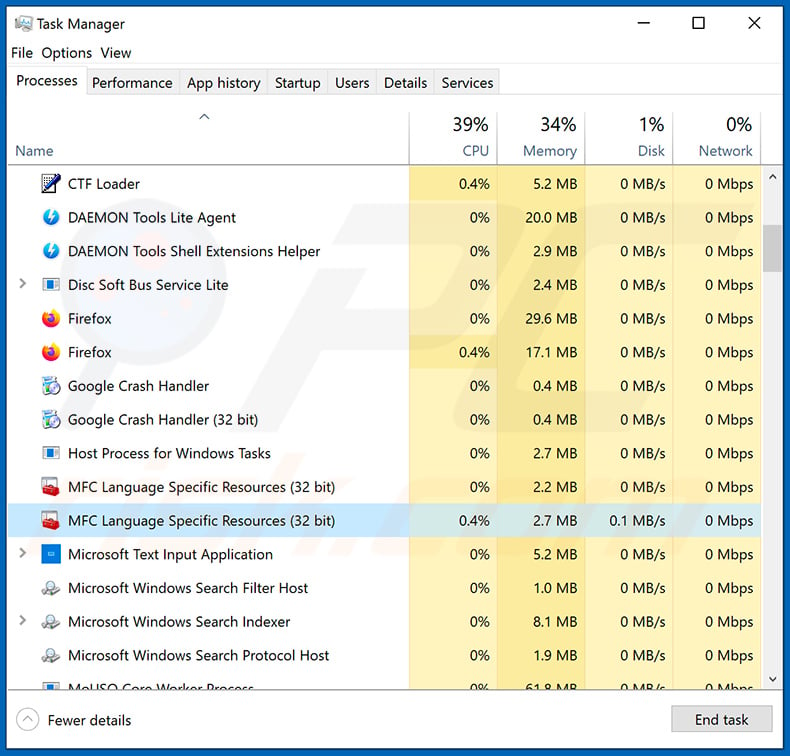
If you checked the list of programs running on your computer, for example, using task manager, and identified a program that looks suspicious, you should continue with these steps:
 Download a program called Autoruns. This program shows auto-start applications, Registry, and file system locations:
Download a program called Autoruns. This program shows auto-start applications, Registry, and file system locations:
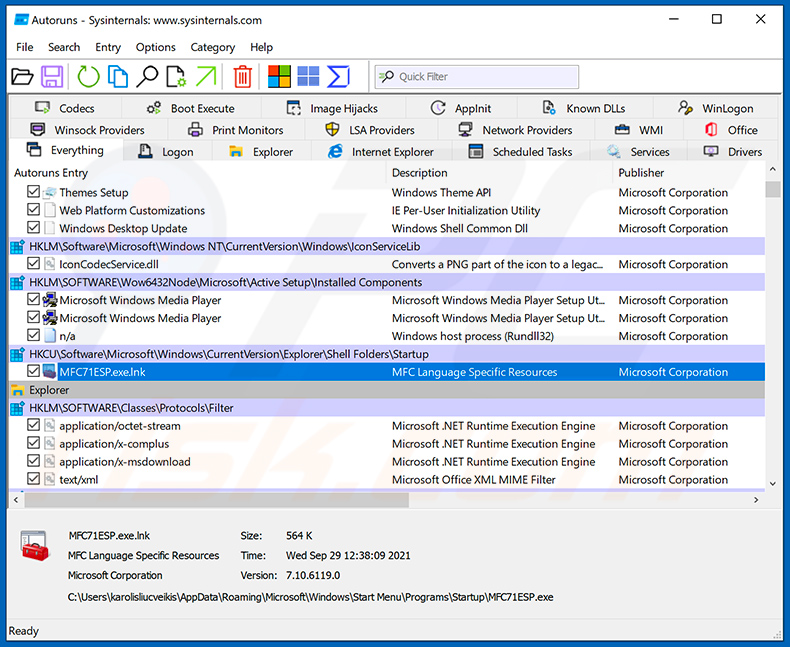
 Restart your computer into Safe Mode:
Restart your computer into Safe Mode:
Windows XP and Windows 7 users: Start your computer in Safe Mode. Click Start, click Shut Down, click Restart, click OK. During your computer start process, press the F8 key on your keyboard multiple times until you see the Windows Advanced Option menu, and then select Safe Mode with Networking from the list.
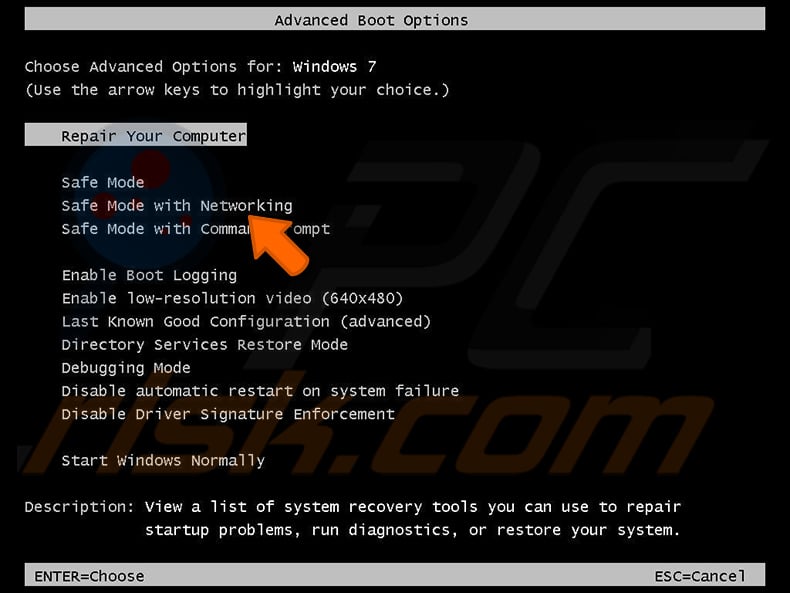
Video showing how to start Windows 7 in "Safe Mode with Networking":
Windows 8 users: Start Windows 8 is Safe Mode with Networking - Go to Windows 8 Start Screen, type Advanced, in the search results select Settings. Click Advanced startup options, in the opened "General PC Settings" window, select Advanced startup.
Click the "Restart now" button. Your computer will now restart into the "Advanced Startup options menu". Click the "Troubleshoot" button, and then click the "Advanced options" button. In the advanced option screen, click "Startup settings".
Click the "Restart" button. Your PC will restart into the Startup Settings screen. Press F5 to boot in Safe Mode with Networking.
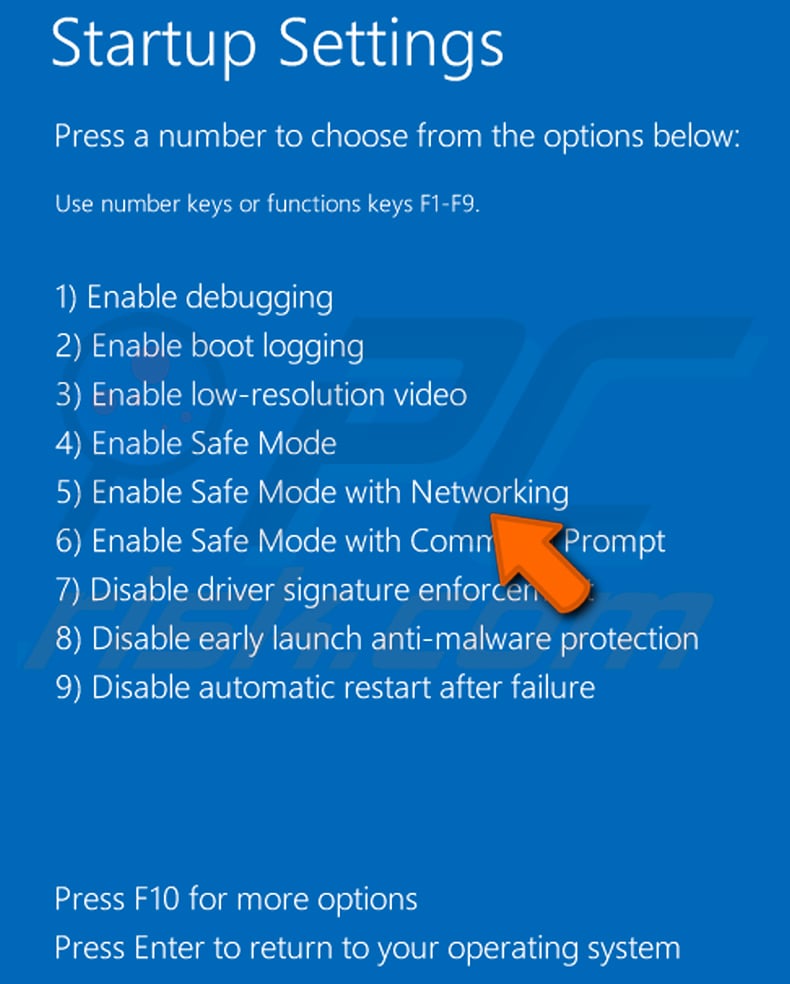
Video showing how to start Windows 8 in "Safe Mode with Networking":
Windows 10 users: Click the Windows logo and select the Power icon. In the opened menu click "Restart" while holding "Shift" button on your keyboard. In the "choose an option" window click on the "Troubleshoot", next select "Advanced options".
In the advanced options menu select "Startup Settings" and click on the "Restart" button. In the following window you should click the "F5" button on your keyboard. This will restart your operating system in safe mode with networking.
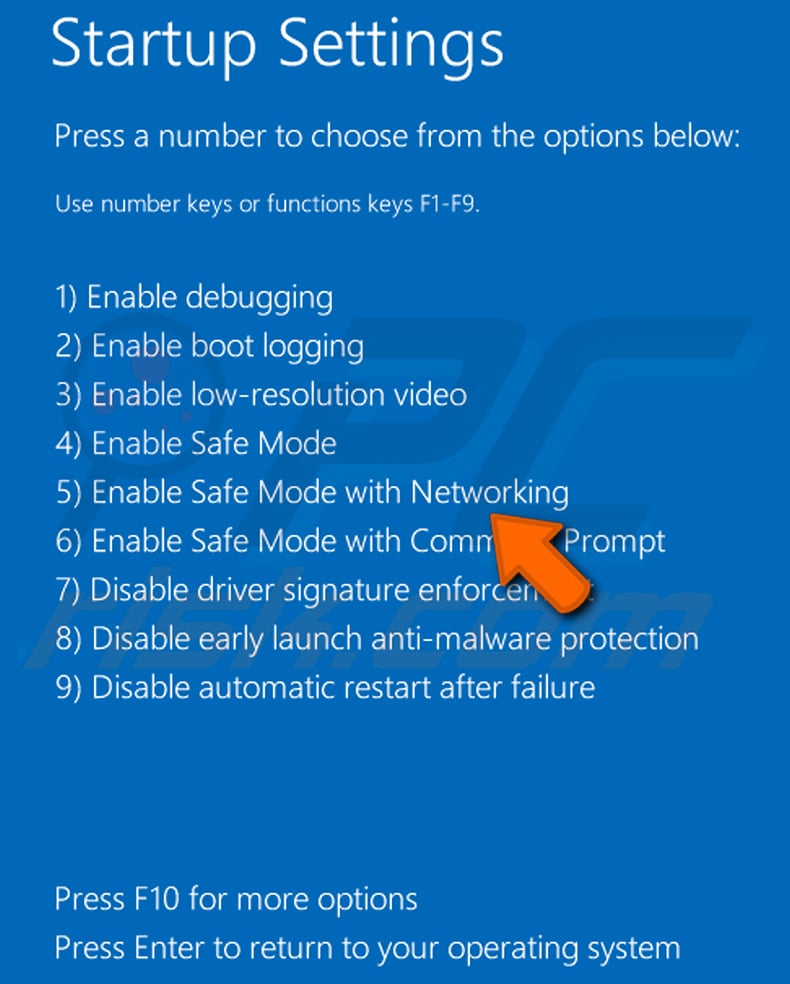
Video showing how to start Windows 10 in "Safe Mode with Networking":
 Extract the downloaded archive and run the Autoruns.exe file.
Extract the downloaded archive and run the Autoruns.exe file.
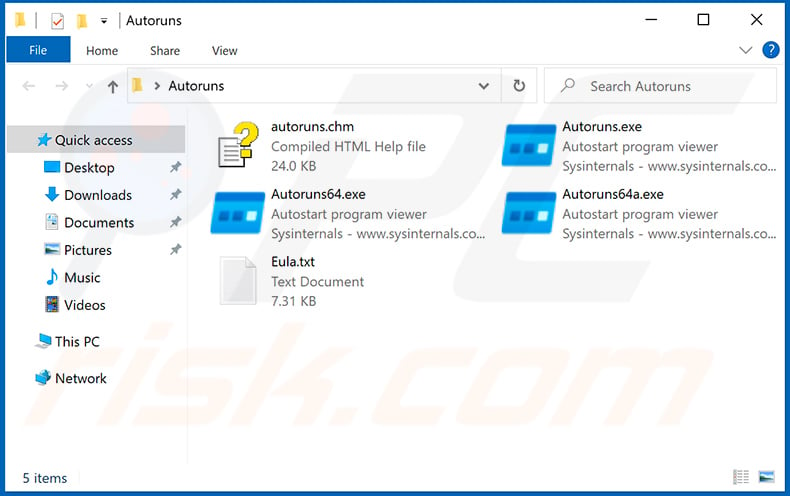
 In the Autoruns application, click "Options" at the top and uncheck "Hide Empty Locations" and "Hide Windows Entries" options. After this procedure, click the "Refresh" icon.
In the Autoruns application, click "Options" at the top and uncheck "Hide Empty Locations" and "Hide Windows Entries" options. After this procedure, click the "Refresh" icon.
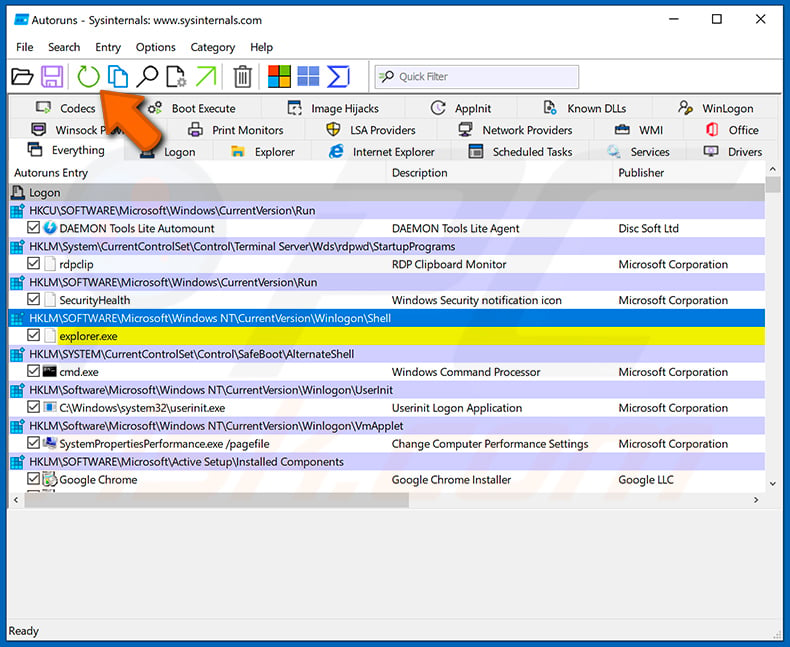
 Check the list provided by the Autoruns application and locate the malware file that you want to eliminate.
Check the list provided by the Autoruns application and locate the malware file that you want to eliminate.
You should write down its full path and name. Note that some malware hides process names under legitimate Windows process names. At this stage, it is very important to avoid removing system files. After you locate the suspicious program you wish to remove, right click your mouse over its name and choose "Delete".
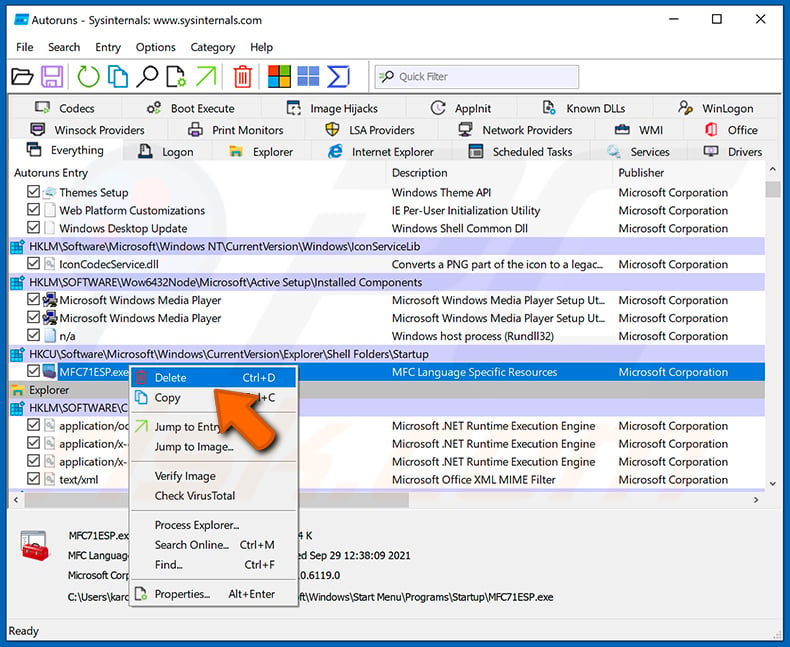
After removing the malware through the Autoruns application (this ensures that the malware will not run automatically on the next system startup), you should search for the malware name on your computer. Be sure to enable hidden files and folders before proceeding. If you find the filename of the malware, be sure to remove it.
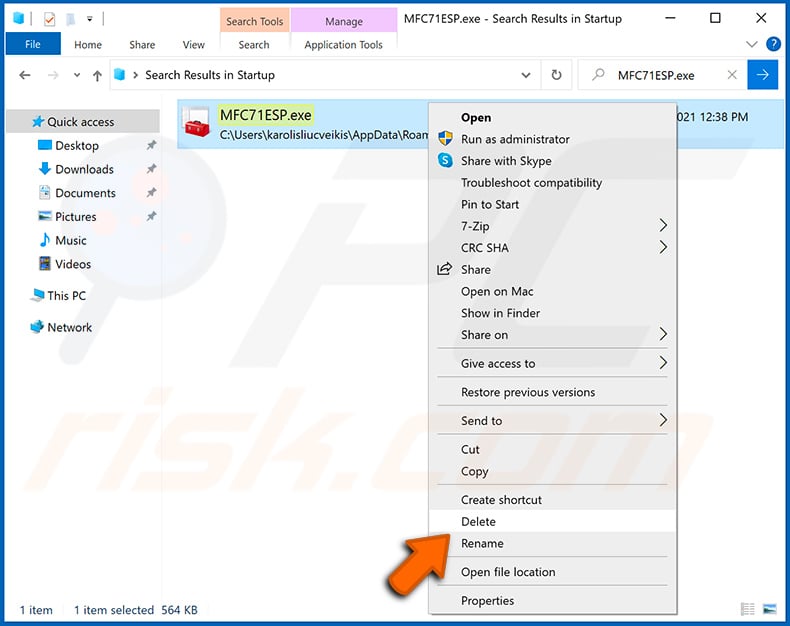
Reboot your computer in normal mode. Following these steps should remove any malware from your computer. Note that manual threat removal requires advanced computer skills. If you do not have these skills, leave malware removal to antivirus and anti-malware programs.
These steps might not work with advanced malware infections. As always it is best to prevent infection than try to remove malware later. To keep your computer safe, install the latest operating system updates and use antivirus software. To be sure your computer is free of malware infections, we recommend scanning it with Combo Cleaner Antivirus for Windows.
Frequently Asked Questions (FAQ)
My computer is infected with SoupDealer, should I format my storage device to get rid of it?
While this method can remove SoupDealer, it will also delete all stored data. Security solutions like Combo Cleaner can usually eliminate the malware without the need to completely wipe the device.
What are the biggest issues that malware can cause?
Malware can steal sensitive data, lock or damage files, slow down systems, execute other malicious programs, etc. Usually, victims have their identities, money, or accounts stolen or encounter other issues.
What is the purpose of SoupDealer?
The purpose of this malware is to secretly gain full remote control over an infected computer. It can carry out many malicious actions such as stealing information, disabling security tools, spreading to other devices, downloading and running additional files, launching DDoS attacks, and more.
How did SoupDealer infiltrate my device?
The malware enters systems mainly through deceptive emails with malicious attachments. It can also come from pirated software, fake tech support scams, malicious ads, compromised websites, third-party downloaders, peer-to-peer platforms, or infected USB drives—usually after users interact with harmful files.
Will Combo Cleaner protect me from malware?
Yes, Combo Cleaner can detect and remove most malware. A full system scan is important since advanced threats often hide deep within the device.
Share:

Tomas Meskauskas
Expert security researcher, professional malware analyst
I am passionate about computer security and technology. I have an experience of over 10 years working in various companies related to computer technical issue solving and Internet security. I have been working as an author and editor for pcrisk.com since 2010. Follow me on Twitter and LinkedIn to stay informed about the latest online security threats.
PCrisk security portal is brought by a company RCS LT.
Joined forces of security researchers help educate computer users about the latest online security threats. More information about the company RCS LT.
Our malware removal guides are free. However, if you want to support us you can send us a donation.
DonatePCrisk security portal is brought by a company RCS LT.
Joined forces of security researchers help educate computer users about the latest online security threats. More information about the company RCS LT.
Our malware removal guides are free. However, if you want to support us you can send us a donation.
Donate
▼ Show Discussion